TechnologyNovember 21, 2022
Industrial wireless technology special report
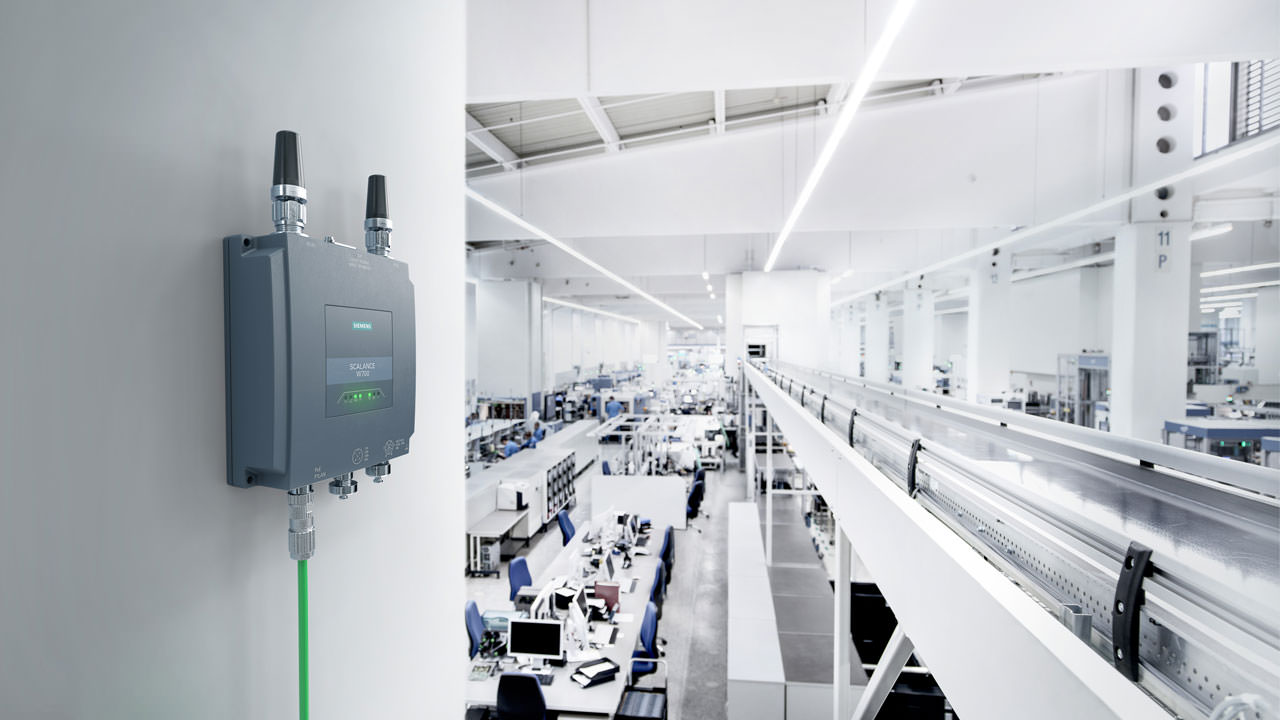
Industry experts provide their perspective on the trends and technology in Industrial Wireless applications. From Industrial 5G to Wi-Fi 6, technology and speed advances -- along with the need for more flexible networking to meet the needs of IIoT applications -- is driving innovations in industrial wireless communication.
Industrial wireless technology offers enabling solutions that are potential game-changers for modern manufacturing.
In this special report on Industrial Wireless technology, the Industrial Ethernet Book has reached out to six industry experts to gain their insights into the the trends in wireless communications, applications and challenges for automation engineers.
5G and Wi-Fi 6
New possibilities for industrial wireless applications.
Jürgen Weczerek, Manager Product Marketing Wireless and Security for Phoenix Contact, told IEB that 5G and Wi-Fi 6 are expanding the application possibilities for industrial wireless in the smart factory.
“These are clearly the latest generations of wireless technologies: for cellular communication it is 5G and for WLAN it is Wi-Fi 6 (IEEE 802.11AX). In the future, both have the potential to be a game changer for the broad use of wireless communication in the smart factory,” Weczerek said.
“Until now, wireless solutions have often only been used on an application-by-application basis, in addition to a wired network, e.g., to communicate with mobile systems. That will continue to be the focus with Wi-Fi 6, just at a very different level regarding reliability, real-time, and performance. This in turn will allow new solution concepts. 5G is particularly designed to enable the entire communication backbone network in a factory to be implemented with a wide range of different applications. To this end, comprehensive functions for managing priorities, resource management, access management, security, etc. are offered. The possibility of using more reliable, real-time, and high-performance wireless communication networks will enable more flexible, autonomous, and efficient processes in manufacturing in the future.”
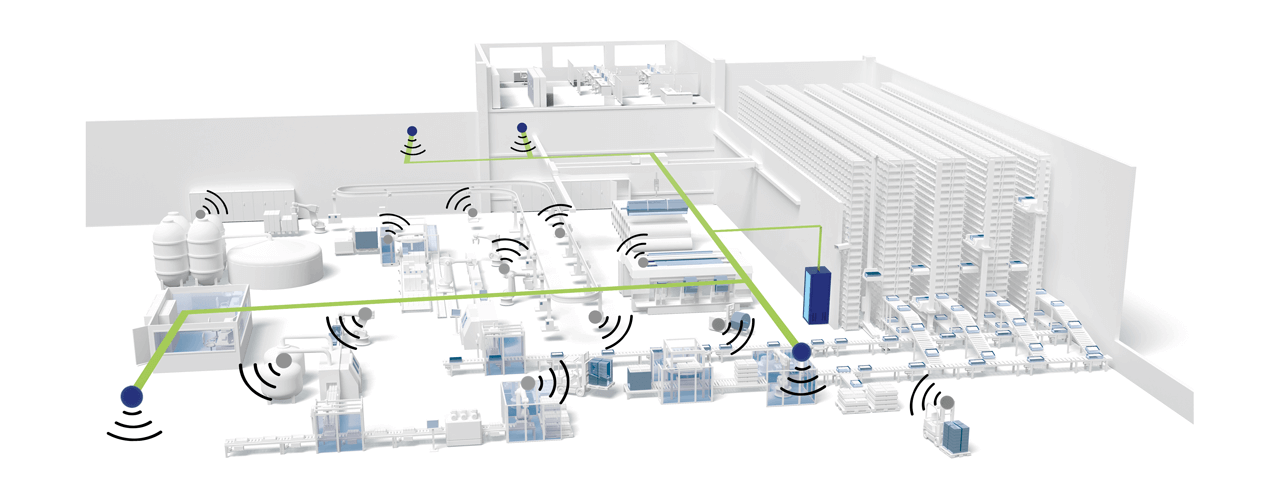
5G is particularly designed to enable the entire communication backbone network in a factory to be implemented with a wide range of different applications.
Industrial wireless application benefits
Despite different network concepts, Weczerek said that both wireless technologies are based to a large extent on the same basic technologies and thus offer comparable advantages compared to previous technologies: more reliable, more real-time capable, larger networks with more devices and much more data throughput. However, much more decisive than the technologies themselves is the use of free, undisturbed transmission channels.
“This is a clear advantage of 5G, that it makes it possible for the first time to operate private networks in their own protected frequency range. WLAN must continue to use public frequency bands even with Wi-Fi 6. But with the opening of the 6 GHz band in many countries, in some cases up to 1,200 MHz of additional bandwidth is available with a maximum of 59 new, largely still unused transmission channels. Therefore, 5G but also Wi-Fi 6 will play a key role in the further digitalization of the factory,” he said.
He added that 5G and Wi-Fi 6 are new communication standards based on a variety of new technologies that improve reliability, real time, performance, and efficiency. Both wireless communication standards, 5G and Wi-Fi 6, can be used very universally because they can be optimized very flexibly to meet individual requirements. Either the real time of small data packets, high data throughput or battery-saving communication with IIoT sensors or a mixture of all is important.
Targeting smart factory applications
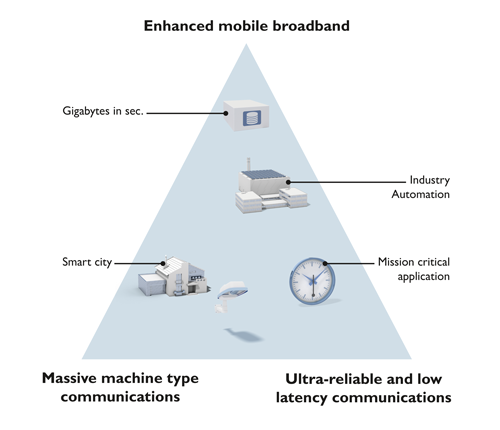 “Today, wireless solutions are often used within applications where wired communication is not possible. Wireless is thus usually only a selective problem solution within the factory, often with limitations in real-time and safety communications. The new wireless technologies such as Wi-Fi 6 and above all 5G enable a complete wireless communication infrastructure within a factory, including real-time and safety communication,” Weczerek said. “In the future, they will be able to replace wired network connections to the greatest possible extent, thus offering greater flexibility and significantly lower connection costs per network device. This makes it possible to easily integrate sensors and intelligent devices everywhere in the network, so that big data, predictive maintenance, cloud connection, etc. become possible easily and economically.”
“Today, wireless solutions are often used within applications where wired communication is not possible. Wireless is thus usually only a selective problem solution within the factory, often with limitations in real-time and safety communications. The new wireless technologies such as Wi-Fi 6 and above all 5G enable a complete wireless communication infrastructure within a factory, including real-time and safety communication,” Weczerek said. “In the future, they will be able to replace wired network connections to the greatest possible extent, thus offering greater flexibility and significantly lower connection costs per network device. This makes it possible to easily integrate sensors and intelligent devices everywhere in the network, so that big data, predictive maintenance, cloud connection, etc. become possible easily and economically.”
He added that, with 5G and Wi-Fi 6, data throughput, real-time characteristics and reliability have also improved significantly, which often limited their possible applications with current technologies. In particular, the availability of exclusively usable frequency ranges with 5G or additional transmission channels with Wi-Fi 6 often make it possible to implement larger and more reliable wireless networks in the factory in the first place.
“In addition, the new technologies offer significantly more options for meeting specific application requirements. However, they are also more complex than the previous technologies, so that specific know-how is required for the planning, implementation, and operation of such wireless networks. This is especially true for 5G and its many options. Anyone planning to deploy such networks should therefore involve specialists,” he said.
Leveraging wireless speeds
Dramatic increases in wireless communication throughput.
According to Dr. Al Beydoun, ODVA President and Executive Director, recent advances in wireless network speed and reductions in latency have fundamentally altered communication. Wireless cellular technology has moved from 3G at 20 Mbit/s speed in the 2000s to 5G at up to 20 Gbit/s speed today, with generational advances taking place approximately every decade.
“The past three Wi-Fi specifications have been released about five years apart, with Wi-Fi 4 allowing download speeds of 600 Mbit/s and Wi-Fi 6 enabling speeds of up to 9.6 Gbit/s. While the generation advancements for both of these technologies have taken place at a linear rate, the speed has increased at an exponential rate,” Beydoun said. “This dramatic increase in wireless communication speed has enabled plant wide wireless networks in automotive for advanced diagnostic analysis and remote connectivity of machines such as palletizers in packaging facilities and instrumentation in oil and gas fields for remote monitoring to support maintenance.”
Wireless communication initially enabled voice for business, then grew in capability to transport data, including video, for business and automation and finally is poised to be a viable solution for control in automation, especially with private and hybrid network option availability for 5G. The next frontier in the continued progression of wireless networks is widespread control in both discrete and process environments, which will get a significant jumpstart from the new 5G and Wi-Fi 6 technologies.
“Wireless communication in an automation environment allows for potential installation cost savings due to reduced need for physical cabling, increased connectivity of devices and instrumentation providing for additional diagnostics, and decreased challenges in routing cables in applications with a high degree of movement such as those requiring tool changers,” Beydoun said. “Additionally, wireless communication enables increased production flexibility with machines and devices becoming easier to move to allow for different products or batches to be made and new motion options including drones and Automated Guided Vehicles (AGVs).”
He added, however, that security is a challenge that must be addressed in order for wireless to truly be viable in automation control applications. New exploitation opportunities can open up from outside the walls of a factory or gates of a plant with wireless. Stray signals can be mitigated with radiating cable and smart placement of the antennae. However, it is very important to authenticate transmitting nodes, to encrypt traffic, and to ensure that configurations cannot be changed without a password or key. As a part of a defense in depth solution, device and edge control level automation traffic can be further protected via solutions such as the CIP Security™ network extension for EtherNet/IP.
Cutting-edge wireless technology
The EtherNet/IP™ industrial communication network communicates data between devices and instruments at the application layer of the ISO/OSI model, using the Common Industrial Protocol, or CIP™ protocol. CIP information is then encapsulated in the transport layer, which use either TCP for larger data packets such as diagnostics or UDP for smaller, more time sensitive data packets such as I/O for EtherNet/IP.
At the network layer, logical addressing Internet Protocol (IP) information is added to make the packet ready for network access. In the datalink layer and the physical layer, the packets are converted to the transmission media. This approach of communicating data via CIP, independent of the transport, network, datalink or physical layers, makes use of different transmission media possible. Therefore, EtherNet/IP can be used across copper, fiber, and wireless to provide users with a high degree of flexibility for use across numerous industrial applications.
Additionally, safety can be provided in wireless applications due to the black channel principle, which requires safety devices to have enough compute, intelligence, and diagnostic capability that the entire factory communication network has zero impact on the ability of the safety devices to detect communication errors.
This means that the physical transmission medium is just another part of the black channel. Application layer safety solutions, such as the CIP Safety™ network extension for EtherNet/IP, can provide fail-safe communication between nodes such as safety I/O blocks, safety interlock switches, safety light curtains and safety controllers in both machine and process automation safety applications up to Safety Integrity Level (SIL) 3 according to IEC 61508.
Figure 1: Wireless Medium Speed, Latency, and Distance
| Wireless medium | Max throughput speed | Typical latency | Type | Distance |
|---|---|---|---|---|
| Zigbee (802.15.4) | 0.25 Mbit/s | 40-350 ms | Mesh | 10-20 m |
| Bluetooth (802.15.1) | 1-2 Mbit/s | 40-100 ms | Point-to-point | 2-5 m |
| Wi-Fi 3 (802.11g) | 3-54 Mbit/s | 1-4 ms | WLAN | 35-100 m |
| Wi-Fi 4 (802.11n) | 72-600 Mbit/s | 1-4 ms | WLAN | 35-100 m |
| Wi-Fi 5 (802.11ac) | 433-6933 Mbit/s | 1-4 ms | WLAN | 35-50 m |
| Wi-Fi 6 (802.11ax) | 600-9608 Mbit/s | 1 ms | WLAN | 35-50 m |
| 5G* | 100-20,000 Mbit/s | 1 ms | Large Area | Wide Area |
“One of the clearest examples of the value of wireless control is for AGVs that transport materials around a factory or warehouse. It’s very costly to create a physical track on the floor for an AGV to travel on and this cost multiplies when process changes require new layouts,” Beydoun said. “Welding cells within automotive have also adopted wireless control in order to remove some of the challenges of electrical interference and running cables in tight spaces with a high degree of movement.
Process automation has long leveraged wireless control for connectivity between remotely located and spread-out instrumentation that are a part of wind farms or oil and gas fields. Additional possibilities include using less cable for hygienic design in food and beverage applications, modular and flexible plant design to prepare for Industry 4.0, and adding data collection sensors to legacy devices for IIoT analysis.”
He added that automation engineers are tasked to leverage new communication technology, such as wireless, to help alleviate labor shortages, to drive down costs, to and to increase output and quality. The ability to utilize wireless AGVs to complete low value add tasks in factories such as moving parts frees up workers to do other more complicated and challenging installation and assembly work that machines cannot do well. Wireless can also enable connection of remotely located or legacy devices, which can provide valuable diagnostics and prognostics that can help to optimize OEE.
“Wireless technologies such as 5G and Wi-Fi 6, among others, will help to drive the increased speed and reduced latency that industrial applications demand. Well-engineered design that takes into account both safety and security will help make wireless the new normal in factories and plants around the globe,” he added. “EtherNet/IP will be one of the key industrial communication protocols that will enable this change due to its media independence enabled by CIPTM communication.”
IIoT creating opportunities for wireless applications
Driven by Industry 4.0 application requirements
Joseph Cheng, Sr. Product Manager of IIoT Development Div. for EtherWAN, told IEB that industrial wireless solutions are a critical element in the development of IIoT networking solutions.
“The Industrial Internet of Things (IIoT) is a step towards making traditional factories into smart spaces. The latest industry trends have been towards greater efficiency and reduced maintenance costs. To this end, there has been an increase in the adaptation of Network Management Software (NMS),” Cheng said. “These NMS systems have proven to be very effective in reducing the labor transportation costs related to switch maintenance. Another important trend is automatic backups when a problem occurs on a device. Lost data equals lost money in many cases. The latest transmission devices are designed with automatic backup functionality.”
“Eventually, existing fixed network technologies will not be able to effectively manage the requirements of Industry 4.0. Identifying and alleviating issues with cellular network capabilities will more than offset the switching costs, and this will prove the practical and financial value of these new networks,” he added.
Industry 4.0 opportunities
Cheng said that Industry 4.0 has created opportunities for expanded industrial wireless solutions and capabilities. IoT devices have various sensors that can monitor the temperature, vibration, voltage, currents, and more. So, these sensors can help with early warning signs of any predicted malfunctions, creating a safer workplace.
It is then critical to create policies and procedures specific to wireless technologies that will become part of the overall corporate information Technology (IT)/operational Technology (OT) strategy. Manufacturers will come to adopt these newer applications and systems as their benefits become increasingly apparent.
“The most important benefit is the flexibility to add devices without making major changes to the network infrastructure. This means the deployment of new devices is easier and cheaper than ever before,” he added.
“This is a key issue when connecting facilities that are physically distant. However, compare with wired infrastructure, cybersecurity risks will become the next problem that cannot be ignored, as with the expectation for remote data access, the focus on cybersecurity is going to carry forward into 2022 and beyond.”
In field sites, IIoT devices connect with edge sensors and meters that generate high volumes of data. Organizing and processing data at the front end will gain the efficiency of backend data management and save cost on transmission.
Connectivity among edge devices and backend SCADA is the one of the vital aspects of success. Reliable connectivity by 4G LTE and VPN is vital to ensure the right data is transferred between systems and equipment uninterruptedly.
Cutting edge technology
Cheng added that, to avoid the worst climate impacts, global greenhouse gas (GHG) emissions must be slashed in half during the next decade and reach net-zero early in the second half of the century.
“A good example of the unique applications of cellular wireless technology is in the ability to set up systems that can monitor and calculate the amount of carbon dioxide produced by manufacturing processes. These calculations are not just per facility, but can finely detect and record CO2 emissions per second,” he said.
In a manufacturing system, a process plan is the combination of diverse production processes and operations. Due to the different processes employed, even a small change in product process design, the impact on the environment will be very different. Also, the carbon emissions caused by auxiliary resource and energy consumptions are mainly including the electrical energy consumption of ancillary equipment in manufacturing plant, for example, lighting, heating, and ventilation.
“Once quantitative values are determined for each unit process and breakdown of carbon emission, a range of improvement opportunities can be identified to monitor the resource and energy consumptions during the entire process planning. Each improvement opportunity has been linked to a positive effect on at least one previously identified carbon emission,” he added.
Industrial wireless solutions and challenges
Connectivity between edge devices and backend SCADA sensors is a vital aspect of a successful integration of the latest wireless technology. Furthermore, reliable connectivity through cellular LTE and VPN connections is vital to ensure the uninterrupted transfer of data between systems and equipment.
The future trend is towards low latency wireless communication technologies that can bridge the gap between existing systems, and become the key motivator for the widespread penetration of wireless communications in automated industrial systems.
“The main challenges faced by automation engineers are meeting the demands for increased efficiency and cost reduction, while also satisfying the need to bring the latest technologies to the field quickly. The industry’s latest industrial wireless solutions satisfy both the need for efficiency, and the required ease of deployment, allowing them to connect legacy SCADA systems with MQTT, for a smooth and uninterrupted data flow,” Cheng said.
“The benefits of factory automation are now well understood. However, these new systems present challenges that are less well-known, and poor implementation can lead to lackluster results. The challenges include high setup costs, unrealistic ROIs, and problems regarding integration and scalability,” he added. “Additionally, overall system flexibility and competent staffing issues need to be taken into account. While none of these issues are insurmountable, managers need to understand both the benefits and possible pitfalls to achieve successful deployment of these technologies.”
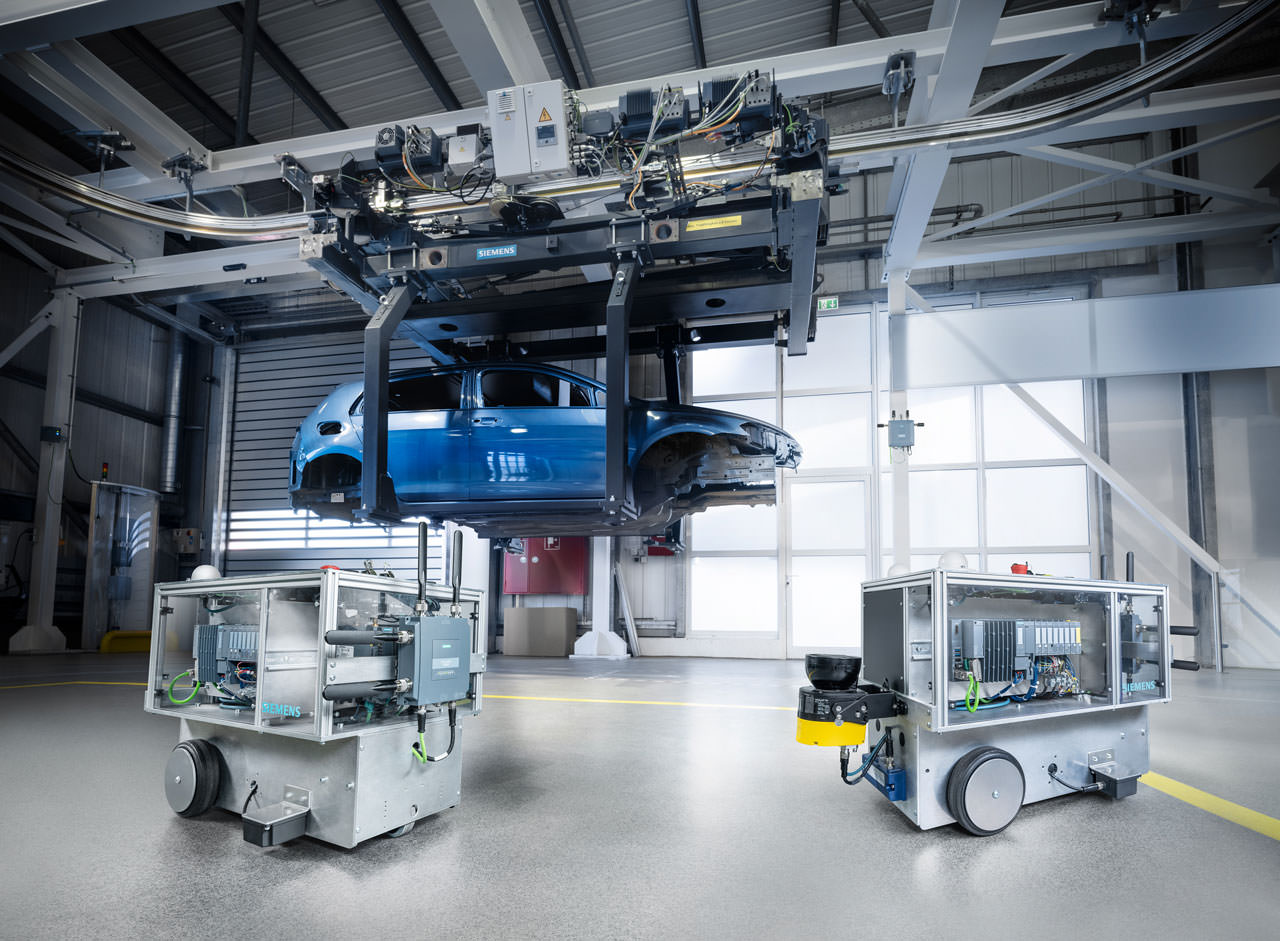
Wireless LAN and 5G are being developed with the needs of the industry in mind, and are creating a promising outlook for the future of flexible factories.
Focus on Industrial 5G
Future proof industrial cybersecurity solutions.
According to Sander Rotmensen, Director of Industrial Wireless Communication for Siemens AG, Industrial 5G will continue to expand its role in industrial wireless applications.
“Demand for more flexibility has grown for years now, therefore wireless technologies have become more important. Around 15 years ago, wireless technologies emerged as the application of choice over slip rings and flexible cables. At that time one of the driving technologies was Wireless LAN, also called Wi-Fi. Demand for Wireless LAN solutions is still growing, especially with the release of the first Industrial Wi-Fi 6 products and the introduction of the new spectrum in the 6 GHz band.” Rotmensen said.
“Therefore, this technology will continue to play an important role in the factories of today and tomorrow. In addition, 5G or to be more specific Industrial 5G, the first cellular technology developed to also fulfill industrial requirements, will play an important role in the future.”
Industrial wireless advantages
“With Wi-Fi 6, we see benefits with regards to latency in a single radio cell while Wi-Fi 6E opens the possibility to use the 6 GHz band, a whole new spectrum range,” Rotmensen added. “When talking about 5G for industry, the biggest benefit is the possibility to set up private networks utilizing licensed spectrum, as well as the future support of reliable low-latency communications. Those are tremendously important to support the flexible factory of tomorrow.”
Rotmensen said that one example would be the lower latency, which can be achieved with Wi-Fi 6 through OFDMA (Orthogonal Frequency Division Multiple Access). It allows an Access Point to send data to up to nine connected clients at the same time. Unfortunately, the standard is not addressing all the industrial needs. Therefore, special industrial enhancements are offered, our so-called iFeatures.
With these features enabled, real-time communication becomes a reality, so we can support wireless safety applications. In addition, the Target Wake Time feature helps to schedule the traffic in a certain cell, which allows lower reaction times and saves power on the wireless interface. Additionally, this can be combined with a so-called sleep-mode and an integrated digital IO. This could power down for example a complete AGV, which is very useful when it comes to battery operated vehicles.
5G addresses three main scenarios: Enhanced Mobile Broadband (eMBB), Massive Machine-Type Communications (MMTC) and Ultra-Reliable Low-Latency Communications (URLLC). EMBB focusses on high bandwidth applications, which are used in our daily lives, but also for remote communication of machines and plants.
MMTC will be focusing on connecting a high number of end-devices, which is interesting in process industry where massive wireless sensor networks are becoming a really interesting possibility.
For discrete manufacturing however, URLLC is very interesting. It will enable ultra-reliable low-latency communications, supporting real-time communication that is necessary for safety applications such as emergency stops.
Industrial wireless solutions
Rotmensen added that, when looking at where we came from a couple decades ago, we mainly saw a focus on increasing the amount of data that can be transmitted in a certain amount of time. This is great when using the technologies at home or in the office. But when looking at industrial usage of wireless technologies, the focus needs to be on reliability and lower latencies.
With Wi-Fi 6 we have seen some progress over the previous versions and with 5G we have the first technology that has been developed focusing on ultra-reliable low-latency communications. These are very promising developments, that will allow even more applications to be supported with wireless technologies in the future.
“One of the biggest challenges is the ability to support mobility and flexibility in the factories today and even more so tomorrow,” Rotmensen said.
“With the next generation of the wireless technologies Wi-Fi and 5G, we can tap into a larger amount of spectrum. This makes it easier to set up larger wireless networks with more end-devices being connected. It also enables us to have networks supporting a combination of mission-critical applications instead of just a single one.”
“Thanks to Wireless LAN and 5G technology, new possibilities are becoming available. The newer iterations of these technologies are now being developed with the needs of the industry in mind as well. All in all, a promising outlook for the future of flexible factories in which I can’t wait to see how these technologies will help us overcome today’s limitations,” he added.
Reliable wireless connectivity
Ultra-reliable wireless backhaul technology solution.
According to Alice Masini, IoT BU – Product Manager for Cisco, key technology trends are helping to enable industrial wireless solutions and applications that are making an impact in the modern factory.
“In every industry, organizations are accelerating their digitization efforts, deploying more automations, and looking for new ways to increase productivity. In manufacturing, we see more and more autonomous guided vehicles (AGVs) and autonomous mobile robots (AMRs) being deployed. In mines or ports, tele-remote operations of cranes, tractors, and dozers is a major trend. These assets need highly reliable wireless connectivity to access their control systems,” Masini said.
She said that Private 5G is now in everybody’s mind, and it is very promising. But it is still not available everywhere and it comes with spectrum, cost, and complexity issues that might be out of reach to many organizations. Private 5G also has a few drawbacks: its ultra-low latency (URLLC) profile is still not available and will offer throughputs of just a few Mbps. So, it is not ideal for these use cases which require both high bandwidth and low latency.
“The key to enable these new industrial applications is to combine several wireless technologies, choosing the ones that best meet the operational requirements. In addition to Wi-Fi 6 and 5G, Cisco offers its URWB technology that is as easy to deploy and use as Wi-Fi, supports mobility use cases with fewer access points and ultra-low latency even at Gigabit speeds,” she added.
Industrial wireless benefits
Masini said that industrial control networks need very high reliability and very low latency, so control loops can run faster, 24/7, enabling manufacturing organizations to grow production outputs. Previously, wireless was mostly used to connect tools, sensors, or handheld devices. Today, critical assets are being connected, so new wireless technologies must meet these requirements as well.
Another major change is that some of these critical assets are now mobile, such as AGVs and AMRs. So high reliability and low latency must now also be ensured on the move with seamless roaming and zero packet loss during handoffs. This is quite a challenge in these industrial environments where harsh conditions, metallic structures and high asset density can create a lot of interferences and issues.
In addition, wireless technologies have a role to play in improving the power consumption of industrial assets. This helps reduce costs as well as improve the sustainability KPI that many manufacturing organizations are now tracking. Only a reliable, predictable, and controlled wireless infrastructure can help optimize the power consumption of every single asset.
“In manufacturing, AGVs and AMRs are deployed to move materials within the factory, and to/from the warehouse, without any driver being involved. Wireless can also be used to quickly reconfigure the production environment or deploy additional machines, sensors, and PLCs to cope with a need of additional resources,” Masini said.
In ports, handling vehicles and cranes are all controlled by complex software tools called terminal operations systems (TOS). They transmit container pictures to optical character recognition (OCR) tools, send their geolocation in real-time and immediately receive instructions on what their next task is. Autonomous vehicles and remotely operated cranes are becoming a reality and send HD video streams to their control platforms. Modern port automation requires reliable wireless technology that can provide perfect radio coverage, low latency, seamless handoff, and high bandwidth.
Finally, workers safety becomes a major key point in some use cases; hazardous conditions monitoring in Oil & Gas or support for anti-fatigue systems in mining, for example, are critical applications which can only be supported by cutting-edge wireless technologies.
Industrial wireless challenges
Masini said that radio interference, high device density, and the need for resiliency, high throughputs, and low latency are probably the main challenges to solve when deploying wireless technologies in modern industrial environments.
The Wi-Fi 6E standard (offering up to 1.2 GHz more spectrum) and even the 5G enhanced Mobile Broadband Profile (eMBB) can address the need for increased throughput while solving concerns regarding interferences and high-density support.
“Low latency and high reliability are key to enable resiliency and are required to support these time-sensitive critical applications. The challenge is even higher when connected devices are moving at high speed, so technologies like the Cisco Ultra-Reliable Wireless Backhaul come into play to support these use cases,” she said.
“Overcoming these challenges is not a mirage anymore, and industrial automation can now benefit from reliable wireless technologies to enable more automation and increase the efficiency.”
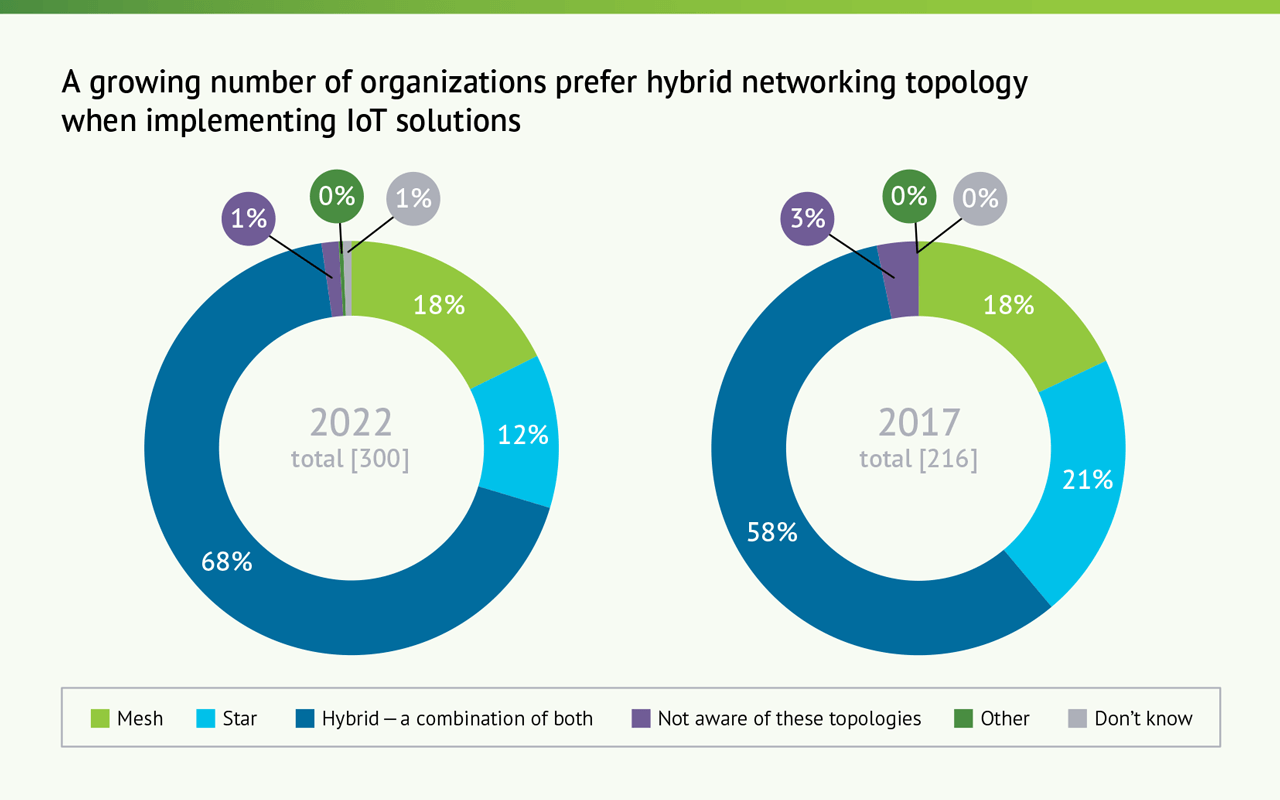
Importance of selecting the right network topology
Reliability and efficiency with mesh networking.
Phil Beecher, CEO and President of the Wi-SUN Alliance, told IEB that selecting the right network topology is critical for industrial applications.
“Wireless communications have been used in industrial environments for many years, but with the development and deployment of standards-based wireless connectivity technology, this is driving the uptake of more advanced applications in factory settings using IoT and IIoT sensors and devices,” Beecher said. “Industrial processes should be efficient, reliable and consistent, meeting well-defined minimum requirements. Designing IoT/IIoT applications and sensors to support a known manufacturing or factory environment should be straightforward. In particularly harsh or hazardous environments for example, devices can be deployed and will just continue working.”
Beecher said that, for a designer of wireless communications, selecting the right network topology is important, and within industrial environments in particular, it is critical to ensure reliability and efficiency. A mesh networking topology provides both reliability and efficiency, as well as scalability and interoperability within these tough environments.
“In a recent Wi-SUN Alliance study, we found that IoT adopters (across a range of industries) are keeping their connectivity options open and looking at multiple network topologies. But there is a general trend towards mesh-based networking, which lost no support among those wanting to use it exclusively over the last 5 years. Star topologies, however, lost traction, with 12% preferring it, down from 21% in 2017,” he said.
Looking specifically at the benefits of wireless mesh technology, it means each device or sensor on a network can speak to other devices, allowing its messages to travel a long distance – hopping between each node in the network.
“Unlike indoor personal area mesh networks (PAN) such as ZigBee and Thread, Wi-SUN FAN (Field Area Network), for example, is specifically designed for a much greater scale of endpoints that will hop over much greater distances to suit smart utilities and industrial environments,” Beecher said.
As an open standards technology, it is based on the IEEE 802.15.4g specification, as well as other IEEE 802 and IETF standards. Developed and promoted by Wi-SUN Alliance, this ensures that devices from multiple vendors conform to the FAN specification and meet the requirements for interoperability.
He added that there’s no room for failure, which is so critical for industrial environments. Mesh networks, like Wi-SUN FAN, when deployed with sufficient density, will have multiple paths back from the end-device to the backhaul network via a router (aka border router) that links it to the Internet of a private wide area network. Wi-SUN FAN is self-forming, which makes adding new devices easy, and self-healing, so that if a pathway fails, the network will automatically re-route to the gateways.
Beecher also mentioned specific application areas that the newest Industrial Wireless solutions are targeting:
- Difficulties with dust and harsh environments are strong incentives to use the technology. In hazardous environments, IoT can be used to keep staff safe, and to help ensure consistency in the production process.
- IoT sensors can be used for predictive maintenance and early detection of faults, wear and tear in machines and parts and anomalies in behaviour, helping to reduce maintenance costs, as well as machine replacement.
- IoT can be used to improve manufacturing security, by ensuring that raw materials are of the right quality and grade, such as in making steel or concrete, and ensuring the end product is fit for purpose for building and critical infrastructure.
- Sensors can also be used to ensure the integrity of safe and unsafe areas, for example, where airflow is monitored for particles in food manufacturing where risk of cross-contamination is critical.


